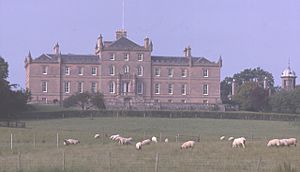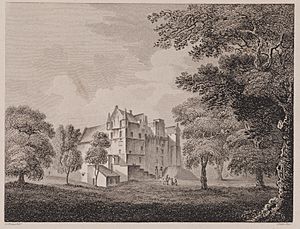Darnaway Castle facts for kids
Darnaway Castle, also known as Tarnaway Castle, is located in Darnaway Forest, 3 miles (4.8 km) southwest of Forres in Moray, Scotland. This was Comyn land, given to Thomas Randolph along with the Earldom of Moray by King Robert I. The castle has remained the seat of the Earls of Moray ever since. Rebuilt in 1810, it retains the old banqueting hall, capable of accommodating 1,000 men.
Etymology
The name Darnaway represents a anglicisation of the Gaelic form Taranaich. Taranaich conserves an early Brittonic form, Taranumagos, derived from the elements taranu meaning "thunder" and magos, "a plain" (Welsh taran-maes).
Randolphs and Douglases
Sir Thomas Randolph probably built the first castle. John, 3rd Earl, died at the Battle of Neville's Cross in 1346 without male heirs, and the earldom went to Patrick Dunbar, who was the husband of one of John's daughters. The male line of the Dunbars failed around 1430, and the earldom went to the Douglases. When Archibald Douglas, Earl of Moray died in battle on 1 May 1455, fighting with his brothers against King James III, who had decided to curb the power wielded by the Douglases, the Moray title and estates were forfeited along with various other Douglas possessions. It now passed to the Murrays, and then to the Stuart family, with whose descendants it remains.
Medieval great hall
The banqueting hall is the only remaining portion of the castle that was erected in 1450 by Archibald Douglas, Earl of Moray, and retains its 15th-century hammerbeam roof, making it one of only two medieval halls in Scotland with its original roof, "a specimen almost unique in Scotland."
The forest of Darnaway was an important source of timber, and in March 1497 King James IV sent a priest David Arnot to supervise carpenters taking "great trees" for the royal artillery. The hall was re-roofed with "spune thak", wooden shingles hewn by a carpenter, at the command of James IV, and on 20 November 1501 the maidens of Forres came to Darnaway to sing for him. James IV kept his mistress Janet Kennedy at Darnaway with their children and her companion Katrine Douglas. In 1502 he sent a lutenist, Adam Dickson, to Darnaway to entertain them. In October 1504 he brought four Italian minstrels and an African drummer, known as the "More taubroner". The maidens of Forres danced for him and the next day, the maidens of Darnaway danced. On 13 October 1505 he played cards at Darnaway, and on 16 October watched dancing described as "capers" or "capparis" in the hall.
The hall was already notable in 1562 when an English observer Thomas Randolph described it as, "verie fayer and large builded." Mary, Queen of Scots visited on 10 September 1562.
Feud
James VI stayed on 14 July 1589. In 1590 a feud started between the Earl of Huntly and the Earl of Moray, after the widow of the Grant of Ballindalloch married John Gordon, son Thomas Gordon of Cluny. John Grant, former Tutor of Ballindaloch, the administrator of the estate, killed one of John Grant's servants. The Earl of Huntly went to Ballindalloch in November 1590 to arrest the Tutor. The Chief of Grant, John Grant of Freuchie promised to deliver the Tutor and his accomplices, accused of murder and other crimes, to Huntly Castle. However, Freuchie joined with the Tutor's men and the Earl of Moray, and came to Darnaway, and there shot pistols at Huntly's officers and cannon from the castle, and killed John Gordon, brother of the Laird of Cluny.
Randolph's leap
To the south of the castle, where the River Findhorn rushes through a gorge, Randolph's Leap commemorates the sort of long-jumping usually associated with Rob Roy MacGregor. It was probably not attempted by Earl Randolph, but by his quarry, Alastair Comyn of nearby Dunphail. Darnaway Estate has acres of hardwood forests. More can be learnt about the tale of Randolph’s Leap at the River Findhorn Heritage Centre at nearby Logie Steading. Darnaway castle is still occupied.



